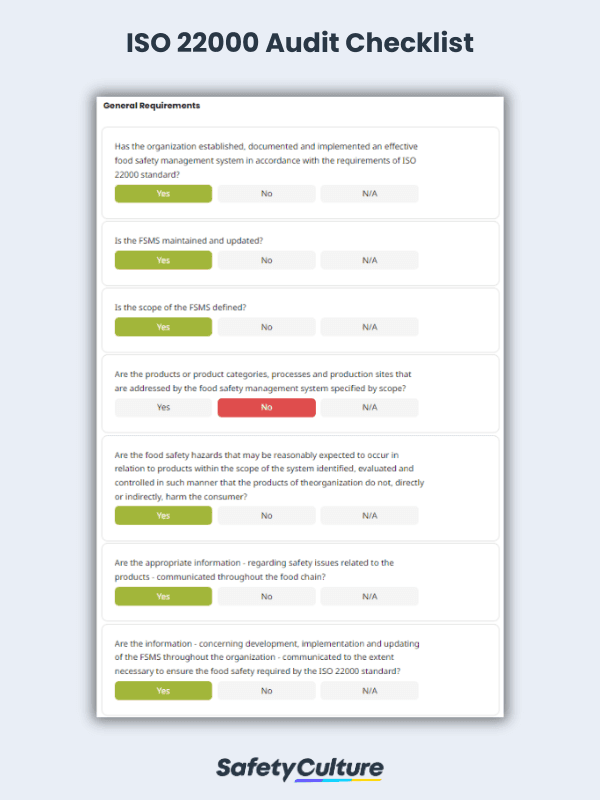What is ISO 22000?
ISO 22000 is a Food Safety Management System (FSMS) that sets global standards to benchmark quality, safety, and processes across food industries. It combines and supplements the core elements of ISO 9001 and HACCP to ensure food safety on the global supply chain, prevents food risks, and control food contamination.
What is ISO 22000 Audit?
ISO 2200 audit is performed by external auditors to evaluate your organization if you are eligible for certification. It is conducted to assess business compliance with:
- applicable statutory and regulatory food safety requirements;
- risk management and corrective actions;
- sanitary and safe environment programs; and
- leadership and management systems.
What is an ISO 22000 Checklist?
An ISO 22000 checklist is a tool used to prepare for, implement and assess Food Safety Management Systems (FSMS). It can be used in the last stage of the internal audit and self-assessment processes in preparation for external auditor certification.
What does an ISO 22000 Checklist Include?
To assess if your Food Safety Management System satisfied ISO 22000 standards, a ISO 22000 checklist should be able to cover the evaluation of the following clauses:
- Clause 4: Food Safety Management System
- Clause 5: Management Responsibility
- Clause 6: Resource Management
- Clause 7: Planning and Realization of Safe Products
- Clause 8: Validation, Verification and Improvement of FSMS
ISO 22000 vs FSSC 2200 vs BRC
One of the most frequently asked questions about ISO 22000 is how different it is from two other renowned food safety standards: FSSC 22000 (Food Safety System Certification) and BRC, now called BRCGS (British Retail Consortium Global Standard for Food Safety). Refer to the table below in order to spot the main differences between ISO 22000, FSSC 22000, and BRC:
ISO 22000 |
FSSC 22000 |
BRC/BRCGS |
|
| Certification Process | 2-stage onsite audit | 2-stage onsite audit | 1-stage onsite audit |
| Certification Approach | Combines and supplements core elements of ISO 9001 (click here to view ISO 9001 checklist) | Framework approach to implement a process-based FSMS | Prescriptive on food safety procedures and guidelines (click here to view BRC requirements) |
| Scope of Requirements | Includes PRPs (pre-requisite programs) and a HACCP-specific food safety plan | Expands ISO 22000 standard with specific requirements (click here to view additional requirements) | Includes a HACCP-specific food safety plan |
| Nonconformity (NC) Closeout / Deadline for Corrective Actions | Within 14 days | Within 30 days | Within 28 days |
| Recertification Period / Validity of Certificate | Every 3 years with surveillance audits once a year | Every 3 years with surveillance audits once a year | Every 6 or 12 months, depending on the assessed grade |
| Recognized by the Global Food Safety Initiative (GFSI) | No | Yes | Yes |
Benefits of Implementing ISO 22000
ISO 22000 helps in improving organizations’ food safety performance. It is a systematic way of addressing food safety issues such as unsafe food importation, foodborne illnesses, food contamination, and insufficient food security. Implementing ISO 22000 will benefit your organization with the following:
Compliance with global regulatory requirements
ISO 22000 sets internationally-recognized food safety standards for controlling food hazards. It helps the organization to grow globally with a recognized food safety processes and prevents costly ramifications, such as fines, penalties, product recalls, or business shutdown.
Promote health and safety regulation
Health and safety regulation is paramount to any businesses. It is implemented across industries to protect and secure your consumers as well as your employees. ISO 22000 helps minimize health and safety risks such as chemical contamination, diarrhoeal diseases, food risks, and work-related incidents and injuries.
Improve food risk response rate
FSMS in place helps businesses to respond immediately to any unexpected food safety issues. It diminishes the time to investigate food safety breaches which can give businesses more time to solve the problem.
Improve business credibility and transparency
Business credibility relies on product expertise and customer feedback. ISO 22000 allows the business to showcase their food safety management systems to ensure and deliver high-quality food products and services.
Increase business development and growth
ISO 22000 helps secure business continual improvement plans on food safety systems. It is used to identify improvement needs and develop new strategies to deliver remarkable products to satisfy the consumer’s needs.
ISO 22000 FAQs
ISO 22000 provides a framework for measuring and assessing food safety risks and performance. It allows an organization’s ability to comply with industry standards related to food safety. While it is voluntary to certify for ISO 22000, it does prove to be beneficial for producers, manufacturers, regulators and retailers, and most importantly consumers. Below are some reasons why it is important to certify for ISO 22000:
The ISO 22000 standard is composed of 10 sections known as clauses. Just like other ISO management system standards, the requirements that needs to be met are clauses 4-10. Which are the following:
- Context of the organization – Define the scope of the Food Safety Management System (FSMS) and the processes and requirements needed to achieve food safety objectives.
- Leadership – Determine the top management (person or group of people) who will be responsible for demonstrating leadership and commitment to FSMS.
- Planning – Determining risks and opportunities of their activities and how they can address them.
- Support – The organization should have the appropriate resources, competence, awareness, communication and documentation to ensure that FSMS is running effectively.
- Operation – requirements for product or service should be well understood and a criteria should be in place to determine whether the organization is able to meet the necessary requirements.
- Performance Evaluation – Establish a system for monitoring and measurement processes (e.g., process performance, internal audits, management review, etc.)
- Improvement – Develop a management system that captures, manage, and resolves nonconformities for continuous improvement.



